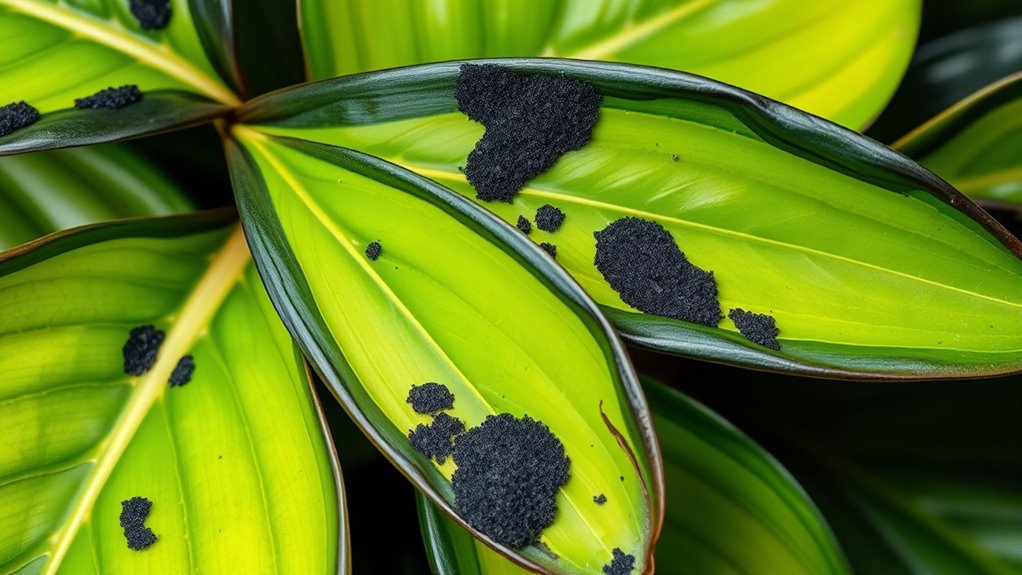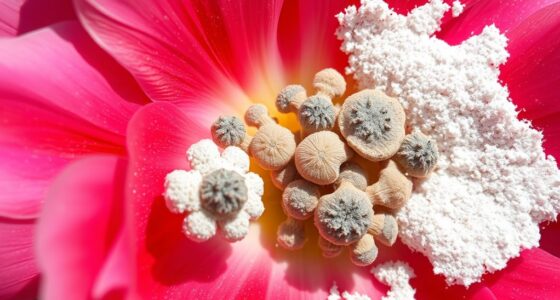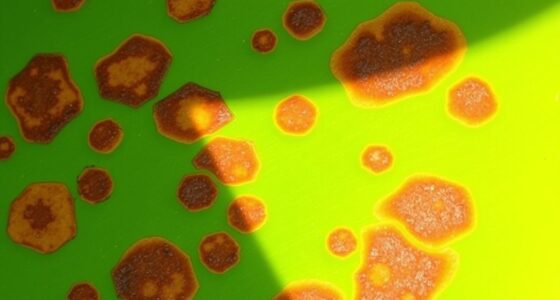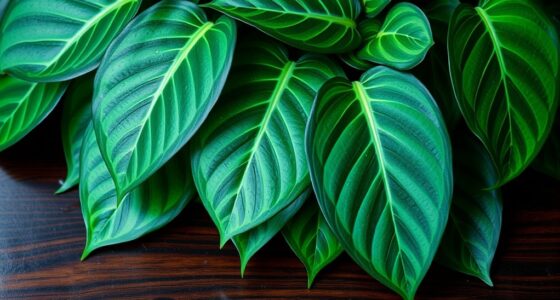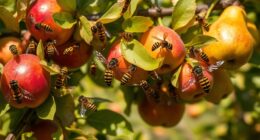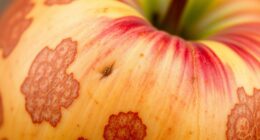If your plumeria leaves turn black, it could be caused by stem rot or sooty mold. Stem rot shows as wet, mushy, dark stems and wilting leaves, often from overwatering or poor drainage. Sooty mold looks like a black powdery coating on leaf surfaces and stems, usually linked to pest infestation like aphids or scale insects. Recognizing these symptoms and their causes helps you take the right action—learn more to protect your plant effectively.
Key Takeaways
- Blackened or browning leaf edges may indicate sooty mold or stem rot; examine severity and associated symptoms.
- Sooty mold appears as a powdery black coating on leaf surfaces, often with sticky residue from pest honeydew.
- Stem rot causes soft, wet, dark patches on stems, with wilting and root damage, unlike the dry, powdery appearance of sooty mold.
- Pest infestations like aphids or scale insects produce honeydew, promoting sooty mold growth on affected leaves and stems.
- Proper diagnosis involves inspecting for moisture issues, pest activity, and tissue texture to determine appropriate treatment.
Recognizing the Symptoms of Blackened Leaves

To identify blackened plumeria leaves early, you need to pay close attention to their appearance. Look for leaves that are turning dark, especially at the edges or tips, which may appear black or brown. You might notice leaves that are wilting or showing signs of discoloration. Proper pruning techniques help remove affected leaves and prevent the spread of problems. When it comes to fertilizer choices, avoid over-fertilizing, as excess nutrients can stress the plant and worsen symptoms. Healthy leaves are usually vibrant and firm, so any sudden darkening or spotting signals something is wrong. Regular inspection allows you to catch issues early, ensuring you can adjust your care routine promptly to keep your plumeria healthy. Additionally, understanding plant stress signs can help you diagnose underlying issues more effectively. Recognizing disease symptoms early can significantly improve your chances of successful treatment and recovery.
Differentiating Between Stem Rot and Sooty Mold

You’ll notice that stem rot causes soft, brown, or black areas on the plant’s stems, often leading to rotting and weakening. Sooty mold appears as a black, powdery coating on the leaves’ surface, usually from pest activity. Understanding these differences helps you identify the cause and choose the right treatment and prevention methods. Additionally, maintaining a healthy environment with proper airflow and cleanliness can reduce the risk of both issues developing. Incorporating preventive measures such as proper watering and pest control can further decrease the likelihood of infestations and infections. Implementing advanced fraud detection techniques can also help protect your transactions from fraudulent activities.
Visible Symptoms Comparison
When examining blackening on plumeria leaves, it’s important to distinguish whether the symptoms result from stem rot or sooty mold, as their appearances can be similar but require different treatments. With stem rot, you’ll notice dark, wet, or mushy areas at the base of the stem, often accompanied by root damage. The affected leaves may wilt or die prematurely. Sooty mold, however, appears as a black, powdery coating on the leaf surface, usually covering the top side and sometimes spreading to stems. This mold often results from pest infestation, such as aphids or scale insects, which produce honeydew that promotes mold growth. These visible symptoms help you identify whether root damage or pest problems are contributing to the blackening.
Cause and Effect Differences
Blackening of plumeria leaves can stem from different causes, primarily stem rot or sooty mold, and understanding their cause-and-effect relationships is key to proper treatment. Stem rot often results from soil contamination, where fungi attack the plant’s stem, leading to blackened, decayed tissue. Pest infestation can weaken the plant, creating entry points for pathogens that cause rot. Sooty mold, on the other hand, develops from a buildup of blackish fungal growth fed by honeydew left by pests like aphids or scale insects. This mold isn’t directly harmful but indicates pest presence.
- Soil contamination spreads fungi, causing stem rot, which leads to blackened, mushy stems.
- Pest infestation releases honeydew, encouraging sooty mold growth on leaves.
- Root or stem damage from rot weakens the plant, making it more vulnerable.
- Pests and contaminated soil are interconnected causes, influencing the appearance of black leaves.
Treatment and Prevention
How can you effectively treat and prevent blackening of plumeria leaves caused by different issues? To address stem rot, improve drainage, remove infected parts, and apply fungicides. For sooty mold, control pests like aphids and scale, and wash leaves with soapy water. Using soil amendments can enhance soil health, preventing conditions that promote rot. Pest control is essential for stopping sooty mold from spreading. Regular inspection, proper watering, and good air circulation are also key components of maintenance. Additionally, understanding the plant disease lifecycle can help in implementing more effective preventative measures.
Causes and Conditions Leading to Stem Rot

Excess moisture around your plumeria can create the perfect environment for stem rot to develop. Poor drainage conditions trap water in the soil, keeping the roots consistently wet. When this happens, the plant’s stem becomes vulnerable to decay and blackening.
Excess Moisture Accumulation
When plumeria plants retain too much moisture around their stems, it creates ideal conditions for stem rot to develop. Excess moisture can result from overwatering issues or high humidity effects, which keep the soil and air saturated. This persistent dampness encourages fungal growth and weakens plant tissues. To understand this better, consider:
- Frequent watering without allowing soil to dry out
- Poor air circulation around the plant
- High humidity levels that trap moisture on stems
- Water splashing onto stems during watering or rain
- Proper watering techniques are crucial to prevent excess moisture buildup and maintain healthy plant conditions. Additionally, humidity control can significantly reduce the risk of stem rot by preventing persistent dampness around the plant.
All these factors increase moisture retention, making your plumeria vulnerable to stem rot. Keeping moisture levels in check helps prevent this condition and promotes healthy growth. Proper watering practices and humidity control are essential.
Poor Drainage Conditions
Poor drainage conditions can quickly lead to stem rot in your plumeria if water doesn’t drain away properly from the soil. When soil drainage is poor, excess water pools around the roots, creating a constantly wet environment that harms root health. Over time, this soggy soil deprives roots of oxygen, weakening their ability to absorb nutrients and fight infections. As roots become compromised, pathogens can invade more easily, causing stem rot and blackened leaves. To prevent this, ensure your soil drains well and avoid overwatering. Using well-draining soil mixes and planting in containers with drainage holes helps maintain proper soil drainage. Keeping roots healthy through proper drainage reduces the risk of stem rot and keeps your plumeria vibrant.
Identifying Sooty Mold on Plumeria Leaves

Sooty mold appears as a dark, powdery coating on the surface of your plumeria leaves, often giving them a blackened look. You’ll notice a shiny, black layer that’s easy to wipe off but quickly returns. To identify it, consider these signs:
- Black, powdery surface—especially on the upper leaf areas.
- Leaf discoloration—yellowing or browning around the mold.
- Sticky residue—a honey-like substance from pest infestation.
- Presence of pests—such as aphids or scale insects, which spread the mold.
Healthy foliage can help prevent the development of sooty mold and support overall plant vigor. If you see these signs, it’s likely sooty mold caused by pest activity, which leads to leaf discoloration and hinders photosynthesis. Addressing the pest infestation is key to controlling the mold.
Effective Treatments for Stem Rot

To effectively treat stem rot in your plumeria, prompt action is essential to prevent the disease from spreading further. Start by using pruning techniques to remove all affected stems and leaves, cutting several inches below the visible rot. Be sure to sterilize your pruning tools with alcohol between cuts to prevent spreading pathogens. After pruning, improve soil health with appropriate amendments like organic compost or well-draining materials to reduce excess moisture that fosters rot. Avoid overwatering and ensure your plumeria is planted in well-draining soil. Applying a fungicide labeled for stem rot can help control the infection, but mechanical removal and soil improvement are your primary defenses. Regular monitoring and prompt treatment are key to preserving your plant’s health. Additionally, understanding personal finance management can help you allocate resources effectively for plant care and treatment supplies. Moreover, practicing proper watering techniques is crucial to prevent future occurrences of rot by maintaining optimal soil moisture levels.
Managing and Preventing Sooty Mold

Managing and preventing sooty mold requires consistent attention to your plumeria’s environment and pest control. First, regularly inspect for pests like aphids or scale, which produce honeydew that fuels mold growth. Second, improve soil nutrition by using balanced fertilizers to strengthen your plant’s defenses, reducing pest attraction. Third, employ proper pruning techniques to remove infested or overcrowded branches, increasing airflow and reducing humidity that favors mold. Fourth, wipe down affected leaves with insecticidal soap or neem oil, targeting pests before they spread honeydew. Additionally, keep your plant’s surroundings clean and remove fallen debris. Using specialized planters can also help optimize drainage and airflow, further preventing mold development. Ensuring proper aesthetic wall organization can contribute to a healthier environment for your plants by reducing excess humidity and encouraging good air circulation. Incorporating adequate watering practices also helps prevent excess moisture that encourages mold growth. Staying vigilant with these practices helps reduce the likelihood of sooty mold developing and keeps your plumeria healthy and vibrant.
Tips for Maintaining a Healthy Plumeria Plant

Maintaining a healthy plumeria requires consistent care and attention to its basic needs. Start with proper pruning techniques to promote airflow and remove dead or diseased branches, which helps prevent conditions like stem rot. Regular pruning also encourages new growth and fuller foliage. Additionally, understand the fertilizer requirements for your plumeria; use a balanced, nitrogen-rich fertilizer during the growing season to support healthy leaves and blooms. Avoid over-fertilizing, as excess nutrients can lead to problems like blackening leaves. Water your plant deeply but infrequently, ensuring good drainage to prevent root rot. Keep an eye on pests and diseases, and adjust care routines as needed. Proper fertilization can also support overall plant health and resilience against issues like plant diseases. Ensuring proper watering practices is essential to prevent fungal issues and other problems. With proper pruning and fertilizing, your plumeria will stay vibrant and healthy.
Frequently Asked Questions
Can Stem Rot Spread to Other Plants Nearby?
Yes, stem rot can spread to nearby plants through disease transmission, especially if they’re close together. When you have affected plants, it’s important to isolate them to prevent the disease from transferring via contaminated tools, water, or contact. Plant proximity plays a key role in disease spread, so spacing your plants properly and practicing good hygiene helps reduce the risk of infection spreading to healthy plants nearby.
Are There Natural Remedies for Preventing Sooty Mold?
To prevent sooty mold naturally, you can try several remedies. Regularly prune your plants to improve airflow, which helps mold prevention. Use a mixture of neem oil or horticultural soap as a natural fungicide to keep mold at bay. Also, wipe leaves with a damp cloth or apply a diluted solution of baking soda and water to reduce mold growth. These natural remedies effectively protect your plants without harmful chemicals.
How Often Should I Water My Plumeria to Prevent Disease?
Think of your plumeria as a delicate dance partner; you want just the right rhythm. Water it deeply but infrequently, about once every 7-10 days during warmer months, adjusting for weather. Proper watering frequency and moisture control prevent overwatering, which can cause stem rot and mold. Always check the top inch of soil—if it’s dry, it’s time to water. Balance is key to keeping your plant healthy and thriving.
Does Soil Type Influence the Development of Stem Rot?
Soil type definitely influences stem rot development. You want soil with good drainage quality and proper composition, like sandy or loamy soil, to prevent excess moisture that fosters rot. Poorly draining soil traps water around the roots, increasing the risk of stem rot. By choosing the right soil composition and ensuring excellent drainage, you help keep your plumeria’s roots healthy and reduce the chances of disease.
Are There Specific Fertilizers That Reduce Mold Growth?
Imagine you’re trying to prevent mold on your plants, and you wonder if specific fertilizers help. Organic fertilizers like compost tea boost plant health and can reduce mold growth by improving soil conditions. In a recent case, gardeners who used organic options saw less mold development compared to chemical fertilizers. So, using organic fertilizers can be an effective strategy for mold prevention, supporting healthier, happier plants.
Conclusion
By paying close attention to your plumeria’s leaves, you’re more likely to catch issues early—just like noticing a sudden black spot on a favorite shirt. Whether it’s stem rot or sooty mold, understanding their signs helps you act quickly. With proper care and timely treatments, you can keep your plumeria healthy and vibrant. Sometimes, a small observation can be the coincidence that saves your plant from lasting damage.
